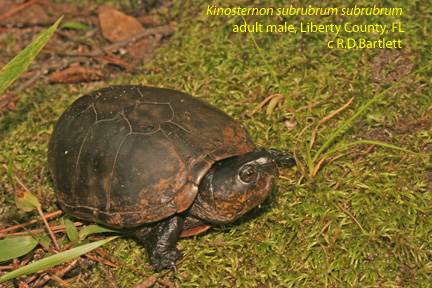
by Rick O'Connor | Mar 3, 2020
This is a new one for many of you… mud turtles. Most have never heard of them. They are very small turtles with oval shaped, domed shells that have hinges similar to box turtles. There are actually two genera within this family of small turtles, the mud turtles (Kinosternon) and the musk turtles (Sternothurus). There are two species of each found in Florida and they differ in that the mud turtles have two hinges on their plastron (belly shell) and the musk only have one. In this post, we will focus on the mud turtles.
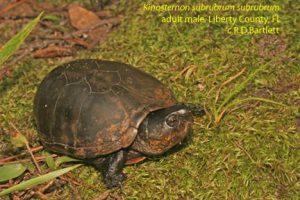
The small, but cool, eastern mud turtle.
Photo: Charles Bartlett
As mentioned above, mud turtles differ in that they have two moveable hinges on their plastron. Also, the scutes (scales) anterior of the anterior most hinge is triangle in shape instead of square. There are two species of mud turtles in Florida. The Striped Mud Turtle (Kinosternon baurii) is a resident of peninsula part of our state. Found from the Apalachicola River to the Florida Keys, this turtle differs from the Eastern Mud Turtle in having three yellow longitudinal stripes on the carapace (though these stripes be faint or missing in the northern part of the state). The carapace has a concave depression on each side of the backbone and the head is usually striped. The length of the carapace is usually not more than 4”.
The Eastern Mud Turtle (Kinosternon subrubrum) has three subspecies. The Eastern Mud Turtle (Kinosternon subrubrum subrubrum) is found in northern Florida and differs from the Striped Mud in having a mottled head in lieu of a striped one. The Florida Mud Turtle (Kinosternon subrubrum steindachneri) also has a mottled head but is found in the peninsula part of the state (but not the Keys). The Mississippi Mud Turtle (Kinosternon subrubrum hippocrepis) has two stripes on the head and is only found in the far western panhandle. This species lacks the stripes and concaved carapace. They too are small, with carapace lengths from 3 – 5 inches. This species has a much-reduced plastron, similar to snapping turtles.
The striped mud can be found in either quiet or flowing waters, where the eastern mud(s) prefer quiet waters with lots of vegetation. In the Florida Keys numerous striped muds have been found in ditches and roadside ponds. They have been in brackish water up to 15 ppt. Stripes are known to make long overland movements during rain and can remain there for several weeks. It is believed they are seeking nesting areas. Eastern muds have been known to make overland movements but not to the extent of the striped muds, and many eastern muds are known to not make these trips at all.
Both species are known to nest in the spring, but the striped muds have a fall nesting season as well. Unusual for turtles, male eastern muds are larger than the females. Male striped muds will have a concave plastron, similar to what the terrestrial turtles (gopher tortoise and box turtles) have. Both will find sandy spots and lay between one and eight small eggs.
Both species are omnivorous. Striped muds like seeds, leaves, and insects. Eastern muds consume primarily insects, crustaceans, and mollusks. Predators are numerous. As with all turtles, just about everyone consumes eggs and hatchlings. Being small, adults have their predators as well. Alligators, snakes, opossums, raccoons, crows, gars, and even blue crabs have been known to take them. The long wanderings of the striped mud have brought many of them into contacts with cars on highways.
The population status is not well known for this group. There are many research gaps that need to be filled. They are not currently listed in Florida, though the striped mud is listed as endangered in the Florida Keys. It appears the primary cause of their decline has been development.
Resource:
Meylan, P.A. (Ed.). 2006. Biology and Conservation of Florida Turtles. Chelonian Research Monographs No. 3, 376 pp.
These are small turtles but have a big heart! They can retract into their shells but will take a snip at one’s hand if not careful. They are pretty cool really and one of the special turtles in our state.
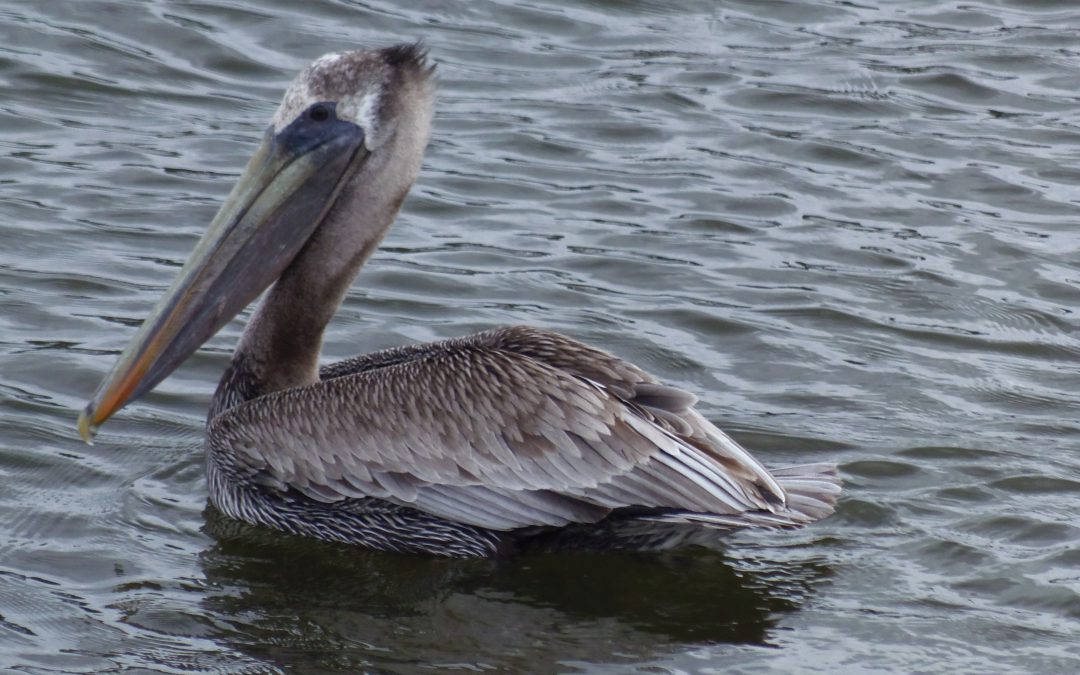
by Rick O'Connor | Feb 21, 2020
The birds…
This is nuts… an article about the birds of the Gulf of Mexico in 500 words or less… right.
Do you know how many species of birds live in and around the Gulf?
It’s a lot…
Birds have the fewest barriers, and the widest range of just about any animal on the planet. They can easily fly over deserts, mountains, and oceans. Most of us have seen gulls in every parking lot in the United States, and we know that many species intentionally migrate over these large landscapes.
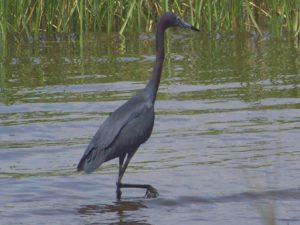
This little blue heron is stalking prey in a Gulf coast salt marsh.
Photo: Molly O’Connor
So, we are going to focus here on just “seabirds”. But how do you define a “seabird”? An ornithologist I worked with many years ago told me – “if it eats seafood… it’s a seabird”. I do not know if all ornithologists would agree with this, but this is what we are going with.
On our barrier islands we find mockingbirds, cardinals, and many other “woodland” birds. Since they do not eat “seafood”, we will not include them here. I have seen seabirds grouped into (a) offshore birds, (b) nearshore birds, and (c) shorebirds. Offshore birds would be those that spend most of their lives on the wing, in flight over open water. Nearshore birds are those that leave land when the sun rises for a day at sea, but eventually return that evening. And shorebirds are near the beach all the time.
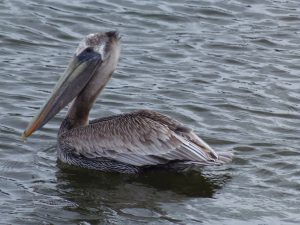
Though still uncommon in some parts of the Gulf, the brown pelican is a very recognizable bird along our shores.
Photo: Molly O’Connor
I used an old bird guide to make a list of such birds that have been found in the Gulf region. As many of you know, some are only seasonal. Published in 1980, Roger Tory Peterson’s Birds of the Eastern United States list 94 “seabirds” that are either full time, or part time, residents of the Gulf. Most (92%) are shorebirds.
This guide suggests there are six species of offshore seabirds that visit the Gulf region. These species have long tapered wings and can remain aloft for hours or days. Many have special glands on their beaks to excrete salt, since they would have to swallow seawater if at sea for a long time. Shearwaters and petrels have been recorded over the southern Gulf. The northern Gannet (which prefers the arctic region) has been reported over the northern Gulf. Two species of boobies have been reported as well.
I was only able to find one record of a “nearshore seabird” and that is the Magnificent Frigate bird, also known as the “Man-o-War” bird. It gets its common name from its habitat of “pirating” food from other seabirds. It can catch food on its own but seems to enjoy stealing from others. They can be seen nearshore on very windy days high above sorrowing almost still with their “bent” wing design. In the southern Gulf they nest on mangrove islands and locals there see them on a regular basis.
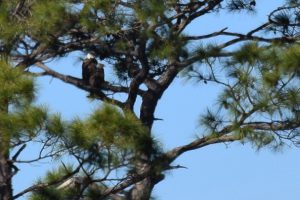
Bald eagles are becoming more common along the Gulf coast.
Photo: Charles Pulley
Based on this guide, there are 87 species of shorebirds in the Gulf region, 59 only winter here. The list is huge and includes loons and cormorants, pelicans and herons, gulls and terns, and the stilt legged birds such as herons and egrets. Many hunters await one of 19 species of duck that spend winter here and in recent years encounters with bald eagles have increased.
Birds lack teeth so they must either grab, or cut, their prey with their bills. Members of the pelican family are famous for their “pouches” which they use to hold food for their young. Oyster catchers can snip open the bivalve with their blade-like bill. The black skimmers have a longer lower bill they dip in the surface of the water as they fly over attracting fish, which the skimmer grabs on its second pass over. Many seabirds are excellent divers and some swim very well, chasing prey beneath the waves.

Many of these shorebirds have been nesting on our barrier islands for thousands of years. Here there are few predators and the warm sand provides a great nesting spot. However, humans have connected these isolated islands to the mainland with bridges and new predators can easily grab the chicks right off the beach. The increase of non-island predators has placed some species on the protected list.
There is a LOT more that can be said about these common and amazing animals. We encourage to take time and do some birding. It is easy, you are already there, and they have no problem displaying their behaviors while you watch.
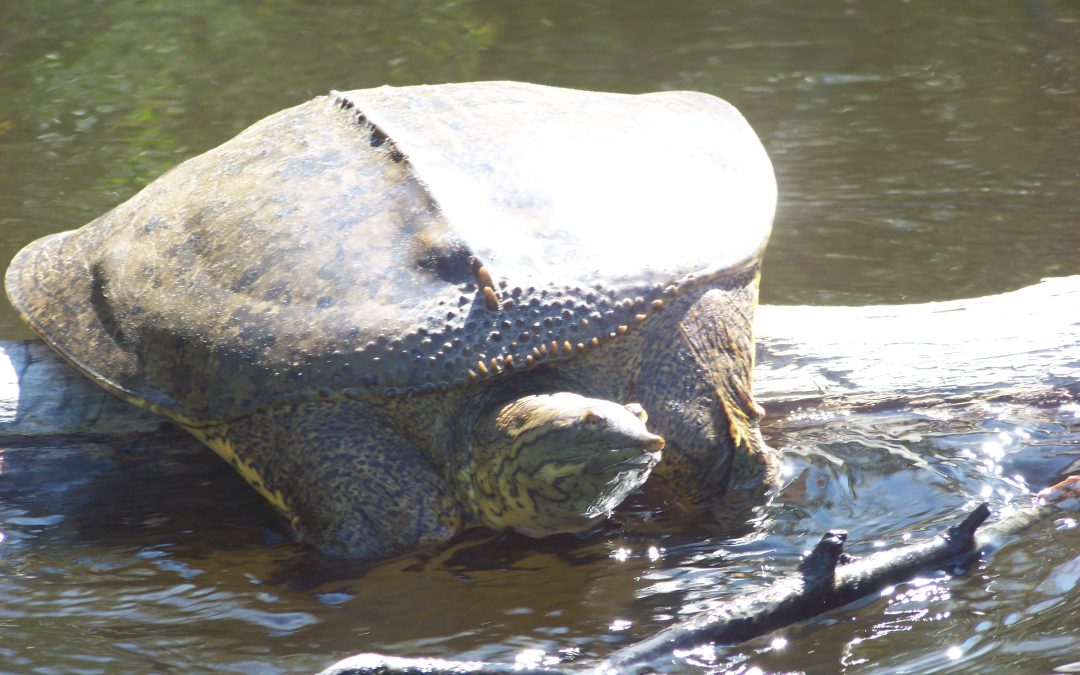
by Rick O'Connor | Feb 20, 2020
These are some of the most unique turtles in the Order Chelonia. Softshells are very distinct with their flat, leathery shells and long tubular snouts. These guys like to lie beneath the sand of Florida’s rivers, buried except their eyes and snout, awaiting passing fish to ambush. They have very long necks to extend their reach during a strike and three sharp bony plates in the roof of their mouths to rip fish flesh. Those handling these should be careful. They have a LONG reach and a nasty bite.
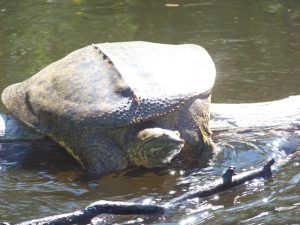
A large Florida softshell turtle basking on a log in Blackwater River.
Photo: Molly O’Connor
There are believed to be 22 species of softshells around the globe but only three live in Florida, and two of those are only found in the western panhandle, one is only found in Escambia County.
The Florida softshell (Apalone ferox) is found throughout the state. Unlike the other Florida species, this one can be found in slow moving streams, ponds, lakes, retention ponds, and even some brackish systems. It prefers to NOT inhabit faster moving rivers. It is the largest of the Florida softshells reaching a carapace length of 30 inches (2.5’) and a mass of 100 pounds! Like many turtles, females are large than males. Besides size, the Florida softshell can be distinguished from the others by the low, round tubercles along the nape of the carapace. This turtle is often seen basking in quiet waterways and will defend itself aggressively. Like many freshwater turtles, Florida softshells nest during daylight hours in sandy soils. They typically lay 15-25 eggs and more than one clutch a year. Unlike other freshwater turtles, sex is not determined by egg temperature but rather by genetics. Though they are fish eaters, much of their diet consist of snails and insects. Crayfish, clams, snakes, turtles, and birds (though rare) have been found in their gut. This species has few predators as adults but are heavily preyed upon by humans for the food markets outside of Florida.
The Gulf Coast Spiny Softshell (Apalone spinifera aspera) is smaller than the Florida softshell, but larger than the Gulf Coast Smooth, with maximum carapace length at 18 inches. They can be distinguished from the other softshells by having spiny, or spike looking tubercles along the nape of the carapace. The hatchlings are tan with numerous small spots and dark thin lines along the margin of the carapace. In Florida, this softshell is only found in the panhandle and in the St. Marys River in Nassau County. It prefers fast moving rivers but will move into quieter waters if the Florida softshell is not present. Like many turtles, they nest during daylight hours in sandy soils during the spring. Clutch size is 20-25 eggs and they lay more than one clutch per year. Incubation is between 60-70 days. They are bottom feeders feeding mostly on crayfish and fish. There are few adult predators and no commercial fishery for this species.
The Gulf Coast Smooth Softshell (Apalone mutica calvata) has only been found in Escambia County within our state. As the name implies, the nape of the carapace does not have the round or spike-like tubercles – rather, it is smooth. It is a smaller softshell, with a carapace length of 12 inches. The young have large circular spots which are harder to see in adults. It has a milder disposition than most softshells, preferring to withdraw into the shell rather than bite. It prefers rivers over other types of water bodies and has only been found in the Escambia River within our state, and only in the upper – faster moving portions of it. They have been found in quiet waters connected to this river. It seems to like sections of the river where sandbars are common, buried in sand near them awaiting fish. They will quickly retreat to the deep part of the river when encountered. The GCSS will use these sandbars for nesting in the spring, laying only about 6-8 eggs, and typically more than one clutch each season. The eggs incubate for 60-70 days and sex is determined by genetics, not temperature. Though fish eaters, insects are much of their diet. There is no commercial fishery for this small turtle.
Like all turtles, nest predation is high for softshells, but river flooding also takes a lot of nests.
All freshwater turtles afford some protection (more some than others). Residents can collect no more than one softshell/day for noncommercial use, no more than two in your possession, and no eggs.
These are really neat looking turtles and it is very exciting to see them while paddling our rivers. We hope you get to see one soon.
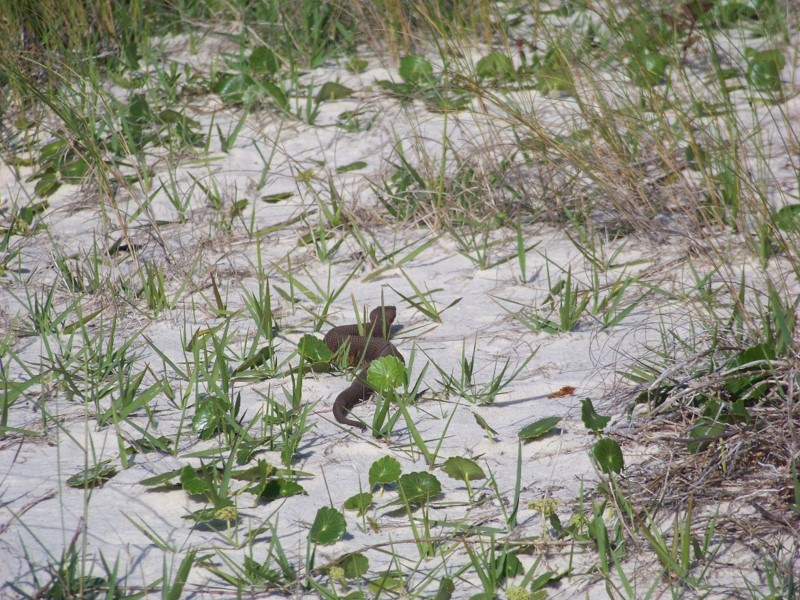
by Rick O'Connor | Feb 13, 2020
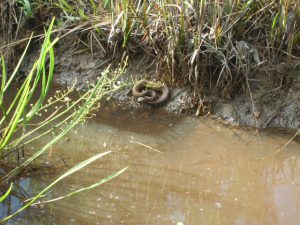
An eastern cottonmouth basking near a creek in a swampy area of Florida.
Photo: Tommy Carter
When you think of reptiles you typically think of tropical rainforest or the desert. However, there is at least one member of the three orders of reptiles that do live in the sea. Saltwater crocodiles are found in the Indo-Pacific region as are about 50 species of sea snakes. There is one marine lizard, the marine iguana of the Galapagos Islands, and then the marine (or sea) turtles. These are found worldwide and are the only true marine reptiles found in the Gulf of Mexico.
Sea turtles are very charismatic animals and beloved by many. Five of the seven species are found in the Gulf. These include the Loggerhead, which is the most common, the Green, the Hawksbill, the Leatherback, and the rarest of all – the Kemp’s Ridley.
Many in our area are very familiar with the nesting behavior of these long-ranged animals. They do have strong site fidelity and navigate across the Gulf, or from more afar, to their nesting beaches – many here in the Pensacola Beach area. The males and females court and mate just offshore in early spring. The females then approach the beach after dark to lay about 100 eggs in a deep hole. She then returns the to the Gulf never to see her offspring. Many females will lay more than one clutch in a season.
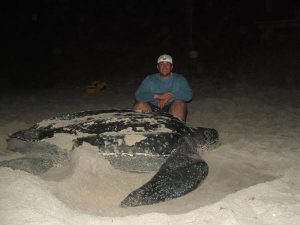
The largest of the sea turtles, the leatherback.
Photo: Dr. Andrew Colman
The eggs incubate for 60-70 days and their temperature determines whether they will be male or female, warmer eggs become females. The hatchlings hatch beneath the sand and begin to dig out. If they detect problems, such as warm sand (we believe meaning daylight hours) or vibrations (we believe meaning predators) they will remain suspended until those potential threats are no more. The “run” (all hatchlings at once) usually occurs under the cover of darkness to avoid predators. The hatchlings scramble towards the Gulf finding their way by light reflecting off the water. Ghost crabs, fox, raccoon, and other predators take almost 90% of them, and the 10% who do reach the Gulf still have predatory birds and fish to deal with. Those who make it past this gauntlet head for the Sargassum weed offshore to begin their lives.
These are large animals, some reaching 1000 pounds, but most are in the 300-400 pound range, and long lived, some reaching 100 years. It takes many years to become sexually mature and typically long-lived / low reproductive animals are targets for population issues when disasters or threats arise. Many creatures eat the small hatchings, but there are few predators on the large reproducing adults. However, in recent years humans have played a role in the decline of the adult population and all five species are now listed as either threatened or endangered and are protected in the U.S. There are a couple of local ordinances developed to adhere to federal law requiring protection. One is the turtle friendly lighting ordinance, which is enforced during nesting season (May 1 – Oct 31), and the Leave No Trace ordinance requiring all chairs, tents, etc. to be removed from the beach during the evening hours. There are other things that locals can do to help protect these animals such as: fill in holes dug on the beach during the day, discard trash and plastic in proper receptacles, avoid snagging with fishing line and (if so) properly remove, and watch when boating offshore to avoid collisions.
If we include the barrier islands there are more coastal reptiles beyond the sea turtles. There are freshwater ponds which can harbor a variety of freshwater turtles. I have personally seen cooters, sliders, and even a snapping turtle on Pensacola Beach. Many coastal islands harbor the terrestrial gopher tortoise and wooded areas could harbor the box turtles. In the salt marsh you may find the only brackish water turtle in the U.S., the diamondback terrapin. These turtles do nest on our beaches and are unique to see. Freshwater turtle reproductive cycles are very similar to sea turtles, albeit most nest during daylight hours.
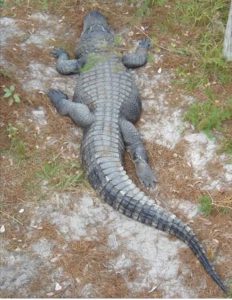
An American Alligator basking on shore.
Photo: Molly O’Connor
The American alligator can also be found in freshwater ponds, and even swimming in saltwater. They can reach lengths of 12 feet, though there are records of 15 footers. These animals actually do not like encounters with humans and will do their best to avoid us. Problems begin when they are fed and loose that fear. I have witnessed locals in Louisiana feeding alligators, but it is a felony in Florida. Males will “bello” in the spring to attract females and ward off competing males. Females will lay eggs in a nest made of vegetation near the shoreline and guard these, and the hatchlings, during and after birth. They can be dangerous at this time and people should avoid getting near.
We have several native species of lizards that call the islands home. The six-lined race runners and the green anole to name two. However, non-native and invasive lizards are on the increase. It is believed there are actually more non-native and invasive lizards in Florida than native ones. The Argentina Tegu and the Cuban Anole are both problems and the Brown Anole is now established in Gulf Breeze, East Hill, and Perdido Key – probably other locations as well. Growing up I routinely find the horned lizard in our area. I was not aware then they were non-native, but by the 1970s you could only find them on our barrier islands, and today sightings are rare.
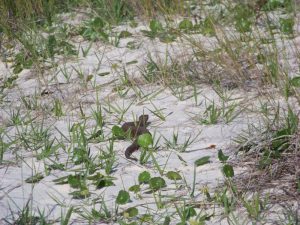
An eastern cottonmouth crossing a beach.
Photo: Molly O’Connor
Then there are the snakes.
Like all reptiles, snakes like dry xeric environments like barrier islands. We have 46 species in the state of Florida, and many can be found near the coast. Though we have no sea snakes in the Gulf, all of our coastal snakes are excellent swimmers and have been seen swimming to the barrier islands. Of most concern to residents are the venomous ones. There are six venomous snakes in our area and four of them can be found on barrier islands. These include the Eastern Diamondback Rattlesnake, the Pygmy Rattlesnake, the Eastern Coral Snake, and the Eastern Cottonmouth. There has been a recent surge in cottonmouth encounters on islands and this could be due to more people with more development causing more encounters, or there may be an increase in their populations. Cottonmouths are more common in wet areas and usually want to be near freshwater. Current surveys are trying to determine how frequently encounters do occur.
Not everyone agrees, but I think reptiles are fascinating animals and a unique part of the Gulf biosphere. We hope others will appreciate them more and learn to live with and enjoy them.
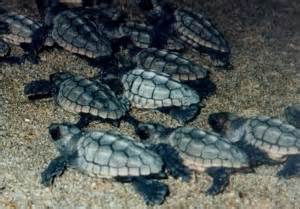
by Rick O'Connor | Feb 5, 2020
This is one of the most beloved animals on the planet… sea turtles. Discussions and debates over all sorts of local issues occur but when sea turtles enter the discussion, most agree – “we like sea turtles”, “we have nothing against sea turtles”. There are nonprofit groups, professional hospitals, and special rescue centers, devoted to helping them. I think everyone would agree, seeing one swimming near the shore, or nesting, is one of the most exciting things they will ever see. For folks visiting our beaches, seeing the white sand and emerald green waters is amazing, but it takes their visit to a whole other level if they encounter a sea turtle.

The largest of the sea turtles, the leatherback.
Photo: Dr. Andrew Colman
They are one of the older members of the living reptiles dating back 150 million years. Not only are they one of the largest members of the reptile group, they are some of the largest marine animals we encounter in the Gulf of Mexico.
There are five species of marine turtles in the Gulf represented by two families. The largest of them all is the giant leatherbacks (Dermochelys coriacea). This beast can reach 1000 pounds and have a carapace length of six feet. Their shell resembles a leatherjacket and does not have scales. Because of their large size, they can tolerate colder temperatures than other marine turtles and found all over the globe. They feed almost exclusively on jellyfish and often entangled in open ocean longlines. There is a problem distinguishing clear plastic bags from jellyfish and many are found dead on beaches after ingesting them. Like all sea turtles, they approach land during the summer evenings to lay their eggs above the high tide line. The eggs incubate within the nest for 65-75 days and sex determination is based on the temperature of the incubating eggs; warmer eggs producing females. Also, like other marine turtles, the hatchlings can be disoriented by artificial lighting or become trapped in human debris, or unnatural holes, on the beach. These animals are known to nest in Florida and they are currently listed as federally endangered and are completely protected.
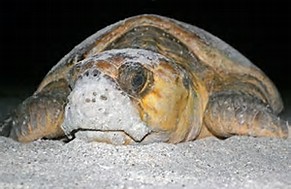
The large head of a loggerhead sea turtle.
Photo: UF IFAS
The other four species are found in the Family Chelonidae and have the characteristic scaled carapace. Much smaller than the leatherback, these are still big animals. The most common are the loggerhead sea turtles (Caretta caretta). As the name suggest, the head of this sea turtle is quite large. Their carapace can reach lengths of four feet and they can weigh up to 450 pounds. The head usually has four scutes between the eyes and three scutes along the bridge connecting the carapace to the plastron. This animal prefers to feed on a variety of invertebrates from clams, to crabs, to even horseshoe crabs. It too is an evening nester and the young have similar problems as the leatherback hatchlings. The tracks of the nesting turtle can be identified by the alternating pattern made by the flippers. One flipper first, then the next. The loggerhead is currently listed as a federally threatened species.
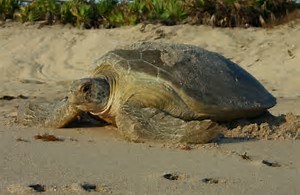
A green sea turtle on a Florida beach.
Photo: Florida Sea Grant
The green sea turtle (Chelonia mydas) is called so not for the color of its shell, but for the color of its internal body fat. They are fans of eating seagrasses, particularly “turtle grass” and other plants, which produce the green coloration of the fat. The fat is used to produce a world favorite, “turtle soup”, and has been a problem for the conservation of this species in some parts of the world. At one time, most green turtles nested in south Florida, but each year the number nesting in the north has increased. They can be distinguished from the loggerhead in that (1) their head is not as big, (2) there are only two scales between the eyes, and (3) their flipper pattern in sand is not alternating; green turtles throw both flippers forward at the same time. Green turtles are listed as federally threatened.
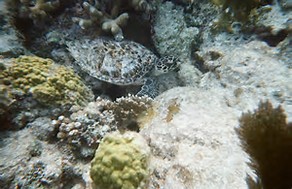
A hawksbill sea turtle resting on a coral reef in the Florida Keys.
Photo: Molly O’Connor
The hawksbill turtle (Eretmochelys imbricata) is more tropical in distribution. They are a bit smaller, with a carapace length of three feet and a weight of 187 pounds, but their diet of sponges is another reason you do not find them often in the northern Gulf of Mexico. To feed on these, they have a “hawks-bill” designed to rip the sponges from their anchorages. Their shell is gorgeous and prized in the jewelry trade. “Tortoise-shell” glasses and earrings are very popular.
The most endangered of them all is the small Kemp’s Ridley sea turtle (Lepidochelys kempii). This little guy has a carapace length of a little over two feet and weighs in at no more than 100 pounds. These guys are commonly seen in the Big Bend area of Florida but for years no one knew where they nested. That was until 1947 when an engineer from Mexico found them nesting in large numbers (up to 40,000) at one time, in broad daylight in Rancho Nuevo, Mexico. This was problematic for the turtle because the locals would wait for the nesting to be complete before they would take the females and the eggs. Protected today they now face the problem that their migratory path across the Gulf takes them through Texas and Louisiana shrimping grounds, and through the 2010 Deep Water Horizon oil spill field. Not to mention that illegal poaching still occurs. Though all species of sea turtles have had problem with shrimp trawls, the Kemps had a particular problem, which led to the develop of the now required Turtle Excluder Device (T.E.D.S) found on shrimp trawls in the U.S. today. Sea turtles have strong site fidelity for nesting and in the 1980s many Kemp’s Ridley eggs were re-located to beaches in Texas in hopes to move the nesting to other locations. The program had some success and they have been reported to nest in Florida. Their diet consists primarily of crabs but there have been reports of them removing bait from fishing lines fishing from piers over the Gulf. This is species is federally endangered and is considered by many to be the most endangered sea turtle species on the planet.

Turtle friendly lighting.
Photo: Rick O’Connor
Sea turtles face numerous human-caused problems including (1) artificial lighting that disorient hatchlings and cause mortality to 50% (or more) of the hatchlings, (2) items left on beaches (such as chairs, tents, etc.) that can impede adults and entrap hatchlings, (3) large holes dug on beaches in which hatchlings fall and cannot get out, (4) marine debris (such as plastics) which they confuse with prey and swallow, (5) boat strikes, sea turtles must surface to breath and can become easy targets, and (6) discarded fishing gear, in which they can become entangled and drown. These are simple things we can correct and protect these amazing Florida turtles.
References
Buhlmann, K., T. Tuberville, W. Gibbons. 2008. Turtles of the Southeast. University of Georgia Press, Athens GA. Pp. 252.
Florida’s Endangered and Threatened Species. 2018. Florida Fish and Wildlife Conservation Commission. https://myfwc.com/media/1945/threatend-endangered-species.pdf,
Species of Sea Turtle Found in Florida. Florida Fish and Wildlife Conservation Commission. https://myfwc.com/research/wildlife/sea-turtles/florida/species/.



















